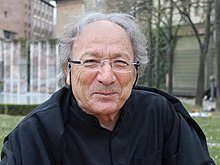Ernest Pignon-Ernest
Appearance


Ernest Pignon-Ernest (born 1942) is a Fluxus and Situationist French artist,[1] born in Nice.
Overview
His first work was done in 1966.[2] It was a reaction to France's Nuclear Strike Force.[2] In 1971, he exhibited posters depicting scenes from the Commune.[3] In 1978-1979, his posters of Arthur Rimbaud could be seen all over France.[4] In 1988-1990, he made drawings of Naples.[5] In 1996, he initiated the collection of international artwork called Art Against Apartheid alongside Antonio Saura.[6]
References
- ^ Deborah Bright, The passionate camera: photography and bodies of desire, Routledge, 1998, p. 180 [1]
- ^ a b Cedar Lewisohn, Street art: the graffiti revolution, Tate, 2008, p. 69
- ^ Bertrand Tillier, 'Les corps piétinés de la Commune: figures de la provocation chez Ernest Pignon-Ernest', in La provocation: une dimension de l'art contemporain (XIXe-XXe siècles), Éric Darragon (ed.), Marianne Jakobi (ed.), Paris: Publications de la Sorbonne, 2004, p. 301 [2]
- ^ Wallace Fowlie (ed.), Seth Adam Whidden (ed.), Rimbaud: complete works, selected letters : a bilingual edition, Chicago, Illinois: University of Chicago Press, 2005, p. xxi
- ^ Philippe Birgy, The art of the city, L'art de la ville, Toulouse: Presses Université du Mirail, 2010, p. 502 [3]
- ^ Sophie Perryer, 10 years 100 artists: art in a democratic South Africa, Struik, 2004, p. 433 [4]
